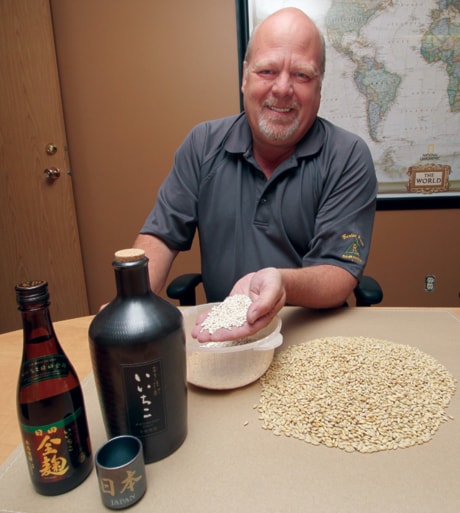Beer drinkers have long benefited from the efforts of Central Alberta barley producers. Now shochu-sippers are enjoying the fruits of their labour as well.
The Alberta Barley Commission, Alberta Agriculture and Rural Development and Rahr Malting Canada have been working together to tap into Japan’s thirst for the distilled alcoholic beverage.
Consumed in the east Asian country for hundreds of years, shochu can be made from various ingredients — including sweet potatoes, buckwheat and wheat, said Bill Chapman, a crop development specialist with Alberta Agriculture. But barley shochu, or mugijochu, is the most desirable.
“I would compare it to a very fine scotch,” he said. “It’s a very smooth drink.”
Chapman added that the Japanese consume shochu in a variety of ways: cold, warm and mixed with water or fruit juices. It’s popular with young people and demand is growing.
Barley for shochu production has been coming from Australia, but thanks to the work of the Barley Commission, Alberta Agriculture and Rahr, Alberta is also a source.
Mike Leslie, the Barley Commission’s CEO, said efforts to supply shochu producers with Alberta barley have been ongoing for a decade. These have involved visits to Japan and shipments of increasingly larger samples. In 2008, Rahr — which runs a malt plant at Alix — sent 10,000 tonnes of barley to Japan.
Bob Sutton, Rahr’s vice-president of sales and logistics, said there are hundreds of shochu producers. He compared it to wine production elsewhere.
“Some of them are very small and some are very large industrial groups.”
The global recession caused the market to plummet last year, but Leslie hopes for a rebound in 2010.
He said the Japanese, who don’t want Australia as their sole source of barley, have been supportive. The sustained drought in Australia should also help.
“The Australians are predicting that they’re going to run out of barley in 2010,” observed Chapman. “Their 2010 crop may not be enough to meet all the requirements.”
Sutton said Rahr hasn’t been contracting farmers to grow barley specifically for shochu. Rather, it’s been taking barley from the malt stocks it buys.
He explained that while the process for malt and shochu production differs, many of the desirable barley characteristics for both are the same.
“It’s got to be a pure lot of a single variety, it’s got to be uniform in size, it’s got to be low-protein, it’s got to be unweathered, bright, healthy-looking barley with a minimum amount of contaminants.”
So far, AC Metcalfe barley has fit the bill. But efforts are underway to develop new and improved alternatives.
“There are a number of varieties we’re evaluating,” said Chapman. “We’ve got our eye on two or three, and we’ve sent samples to the Japanese for their evaluations.”
Much of this development work has occurred at the Field Crop Development Centre at Lacombe, where near-infrared spectroscopy is being used to assess samples. And test locations have been set up at Lacombe, Trochu, Olds, Morrin and Calmar.
“It’s a long, painful process, and in the end a lot of it comes down to, ‘What does it taste like?’” summed up Sutton.
The development work has received a boost with the announcement of $1.08 million in federal funding for Alberta’s shochu barley selection program.
“Without the federal funding, we probably wouldn’t be able to complete the next level,” said Chapman.
Leslie agreed that the money will allow the search for new shochu barley varieties to continue, and at a faster pace.
“In the past, we’ve struggled along with about $10,000 a year.”
The Alberta Barley Commission is already looking beyond shochu. It’s investigating new varieties of grain that could be used by the Japanese for barley tea.
hrichards@www.reddeeradvocate.com
